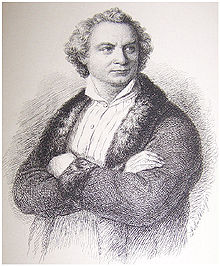
Friedrich von Gärtner
Encyclopedia


Germany
Germany , officially the Federal Republic of Germany , is a federal parliamentary republic in Europe. The country consists of 16 states while the capital and largest city is Berlin. Germany covers an area of 357,021 km2 and has a largely temperate seasonal climate...
architect
Architect
An architect is a person trained in the planning, design and oversight of the construction of buildings. To practice architecture means to offer or render services in connection with the design and construction of a building, or group of buildings and the space within the site surrounding the...
.
Gärtner and Leo von Klenze
Leo von Klenze
Leo von Klenze was a German neoclassicist architect, painter and writer...
are the most well known architects of Bavaria
Bavaria
Bavaria, formally the Free State of Bavaria is a state of Germany, located in the southeast of Germany. With an area of , it is the largest state by area, forming almost 20% of the total land area of Germany...
during the reign of Ludwig I
Ludwig I of Bavaria
Ludwig I was a German king of Bavaria from 1825 until the 1848 revolutions in the German states.-Crown prince:...
. His architecture was generally in the Romanesque
Romanesque architecture
Romanesque architecture is an architectural style of Medieval Europe characterised by semi-circular arches. There is no consensus for the beginning date of the Romanesque architecture, with proposals ranging from the 6th to the 10th century. It developed in the 12th century into the Gothic style,...
style and much to the king's taste. In 1822 Friedrich von Gärtner was appointed artistic director of the Nymphenburg Porcelain Manufactory
Nymphenburg Porcelain Manufactory
The Nymphenburg Porcelain Manufactory , manufacturer of Nymphenburg porcelain, is situated in the Nymphenburg Palace in Munich, capital of Bavaria, and since the mid-eighteenth century has been manufacturing porcelain of high artistic value.- History :After his accession in 1745 Maximilian III...
. From 1842 he was the director of the Academy of Fine Arts in Munich.
Gärtner's Ludwigskirche
Ludwigskirche (Munich)
The Catholic Parish and University Church St. Louis, called Ludwigskirche, in Munich is a monumental church in neo-romanesque style with the second-largest altar fresco of the world...
in the Ludwigsstrasse in Munich strongly influenced other church architecture, especially in North America. He is buried in the Alter Südfriedhof
Alter Südfriedhof
The Alter Südfriedhof is a cemetery in Munich, Germany. It was founded by Duke Albrecht V as a plague cemetery in 1563 about half a kilometer south of the Sendlinger Gate between Thalkirchner and Pestalozzistraße.-History:...
in Munich.
Main Works
- In MunichMunichMunich The city's motto is "" . Before 2006, it was "Weltstadt mit Herz" . Its native name, , is derived from the Old High German Munichen, meaning "by the monks' place". The city's name derives from the monks of the Benedictine order who founded the city; hence the monk depicted on the city's coat...
- FeldherrnhalleFeldherrnhalleThe Feldherrnhalle is a monumental loggia in Munich, Germany. It was built between 1841 and 1844 at the southern end of Munich's Ludwigstrasse next to the Palais Preysing and east of the Hofgarten. Previously the Gothic Schwabinger Tor occupied that place...
- SiegestorSiegestorThe Siegestor in Munich, is a three-arched triumphal arch crowned with a statue of Bavaria with a lion-quadriga, similar in style to the Arch of Constantine in Rome, the Marble Arch in London, the Arc de Triomphe in Paris and the Brandenburger Tor in Berlin...
- University buildingLudwig Maximilians University of MunichThe Ludwig Maximilian University of Munich , commonly known as the University of Munich or LMU, is a university in Munich, Germany...
- Bayerische Staatsbibliothek
- Feldherrnhalle
- Pompejanum in AschaffenburgAschaffenburgAschaffenburg is a city in northwest Bavaria, Germany. The town of Aschaffenburg is not considered part of the district of Aschaffenburg, but is the administrative seat.Aschaffenburg is known as the Tor zum Spessart or "gate to the Spessart"...
- Kursaal in Bad KissingenBad KissingenBad Kissingen is a spa town in the Bavarian region of Lower Franconia and is the seat of the district Bad Kissingen. Situated to the south of the Rhön Mountains on the Franconian Saale river, it is a world-famous health resort.- Town structure :...
- He began the BefreiungshalleBefreiungshalleThe Befreiungshalle is a historical classical monument upon Mount Michelsberg above the city of Kelheim in Bavaria, Germany. It stands upstream of Regensburg on the river Danube at the confluence of the Danube and the Altmühl, i.e...
in KelheimKelheimKelheim is a municipality in Bavaria, capital of the district Kelheim. It is situated at the confluence of Altmühl and Danube. As of June 30, 2005, the town had a population of 15,667....
that was redesigned by the architect Leo von KlenzeLeo von KlenzeLeo von Klenze was a German neoclassicist architect, painter and writer...
and built accordingly. - Royal palace in AthensAthensAthens , is the capital and largest city of Greece. Athens dominates the Attica region and is one of the world's oldest cities, as its recorded history spans around 3,400 years. Classical Athens was a powerful city-state...
, building now used as the Hellenic ParliamentHellenic ParliamentThe Hellenic Parliament , also the Parliament of the Hellenes, is the Parliament of Greece, located in the Parliament House , overlooking Syntagma Square in Athens, Greece....

